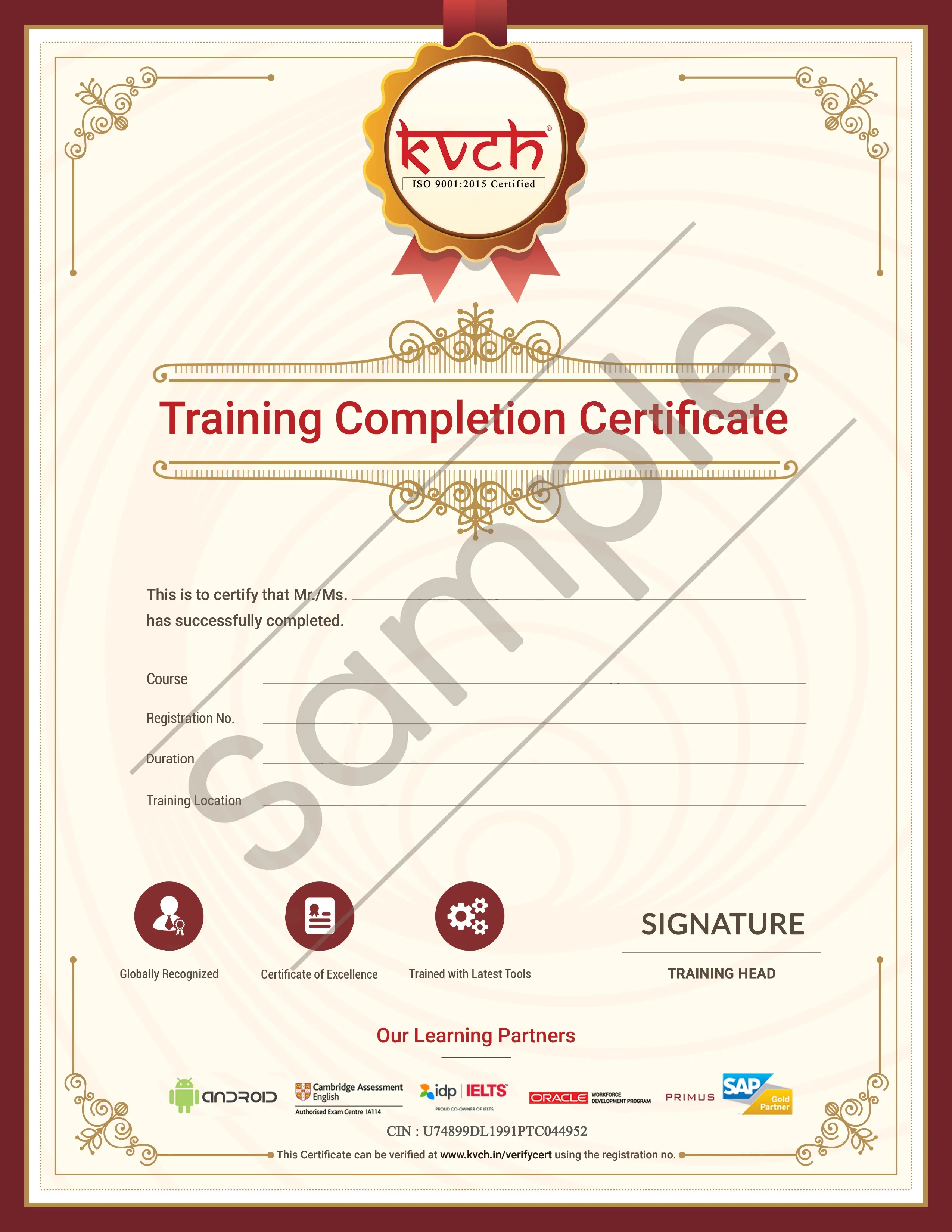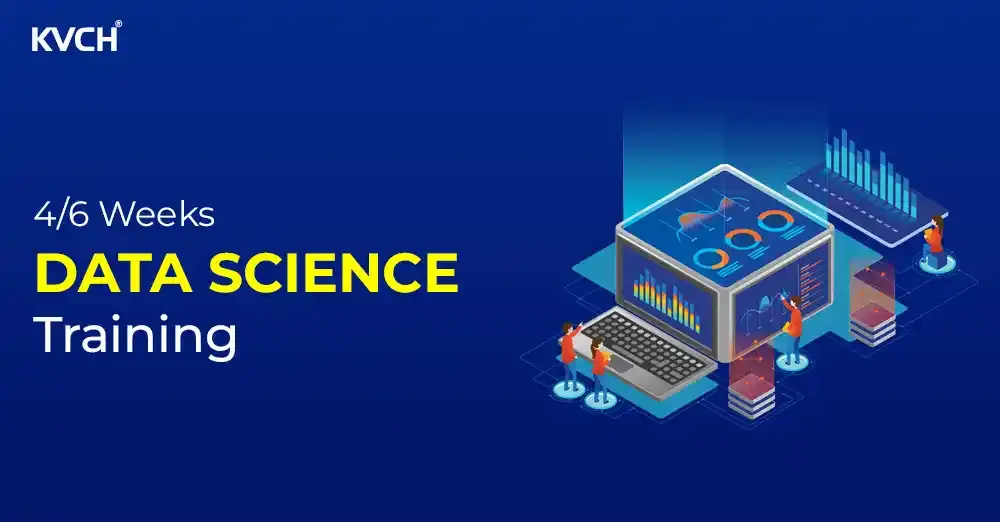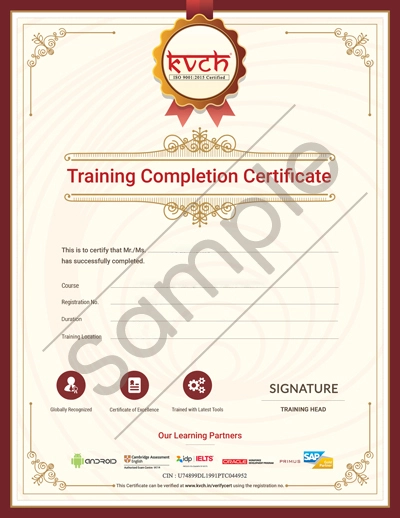

Dive into the world of Data Science this summer with KVCH industrial training program and unlock the path to becoming a skilled Data Scientist.
4.8 (out of 5 based on 65489 votes)



KVCH's Data Science training program offers specialized instruction and a focus on individual skill development. The program is designed to enhance employability by providing intensive training sessions and practical projects. By Apply Data Science Training Program at KVCH, participants gain comprehensive knowledge and skills necessary to secure employment as data scientists. This certification program allows students to delve into the intricacies of data science by working on cutting-edge use cases and projects, applying their learnings to real-world scenarios.

The Data Science Training Program at KVCH aims to achieve the following objectives:
Upon completion of the Data Science course, participants can pursue various career paths, leveraging their acquired skills. Professionals with data science expertise have opportunities in the following roles:
Data scientists command competitive salaries due to the increasing demand for their expertise. Salary expectations post training in the field of data science are as follows:
Data Science has gained popularity due to its ability to quickly and accurately analyze vast amounts of data from various sources, providing actionable insights for informed decision-making. The applications of data science are widespread across industries such as marketing, healthcare, banking, finance, policymaking, and many more.
Several industries are actively hiring professionals with data science skills. The top hiring industries in data science include:
When you've developed your data science abilities and amassed significant experience, you can branch out into related fields like marketing and sales, or data quality, finance, and business intelligence, or even take on a consulting role with an industry leader that relies heavily on data.
Upon successful completion of the Data Science Training Program, participants receive a certificate from KVCH, validating their proficiency in cutting-edge data science methods. This certification establishes individuals as data science specialists within their respective organizations. It adds credibility to their resumes and enhances their job market competitiveness. Furthermore, the skills acquired through this training program allow participants to mine data effectively, contributing to the success of their employers in various ways.
Data Science is a powerful analytics platform to make discoveries. By using different aspects of computer science, data visualisations, data analytics, statistics, R and Python Programming in data science, you may convert voluminous data into meaningful contents.
Sets, Tuples and Looping Programming
Exception and File Handling, Module, Function and Packages
Data Automation (Excel, SQL, PDF etc)
Data Analysis & Visualization
Introduction to Data Science
Accessing/Importing and Exporting Data
Data Manipulation: Cleansing - Munging Using Python Modules
Data Analysis: Visualization Using Python
Introduction to Statistics
Introduction to Predictive Modelling
Data Exploration for Modelling
Data Pre-Processing & Data Mining
Introduction to Machine Learning
Techniques of Machine Learning
Regression
Classification
Unsupervised Learning: Clustering
Structure your learning and get a certificate to prove it.

KVCH experts with in-depth knowledge create a focused learning environment by presenting learners with real-world industry problems and focusing on solutions.
During our certified training, seasoned instructors and industry experts conduct remote sessions to share their extensive knowledge with the learners.
Professionals can obtain in-depth knowledge of cutting-edge digital marketing training by taking advantage of the availability of specialised certificates.
Through a ticketing system that operates around the clock, our technical support staff is available to answer any questions you may have.
Upon finishing the course and the assigned tasks, you will be awarded a certificate from KVCH, recognising your accomplishment as a data scientist.
There is a quiz at the end of each lesson that must be completed before the next lesson begins to test your understanding.
Structure your learning and get a certificate to prove it.


On successful completion of the training, you are awarded with a Certificate in 4/6 Weeks Data Science. The certificate is recognised by top companies and helps in career growth.

Once you get your certificate, you can share it on your online profiles like LinkedIn. Sharing your certification with your connections will help you acquire your dream job.
The Data Science summer training program at KVCH is available for a duration of either 4 or 6 weeks, depending on your preference and the depth of knowledge you want to acquire.
The curriculum of the Data Science summer training program is carefully designed to cover the fundamental concepts of data science, including statistical analysis, machine learning algorithms, data visualization, and data analysis techniques. It also includes hands-on projects and real-world case studies to enhance practical learning.
No, prior knowledge or experience in data science is required to Apply summer training program. The program is designed to cater to beginners and individuals from diverse backgrounds who are interested in exploring the field of data science.
Yes, upon successful completion of the Data Science summer training program at KVCH, you will be awarded a certificate that validates your proficiency in data science concepts and techniques. This certificate holds value in the industry and can boost your career prospects.
The Data Science summer training program emphasizes practical learning. You will have the opportunity to work on real-world projects and use industry-standard tools and technologies. This practical exposure will enhance your skills and enable you to apply data science techniques effectively in professional settings
Yes, KVCH provides placement assistance to students who successfully complete the Data Science summer training program. Our placement team will guide you in preparing for job interviews, conducting mock interviews, and providing valuable feedback on your resume. We strive to help you kickstart your career in data science with confidence.
Overall a very informative training session. Course content got well covered and also demonstrated the concept very well. Thanks for such an informative and concept-clearing training session.

I had a great time doing this course and everyone involved in the KVCH has made it a great experience. I look forward to doing more courses with you guys in the future and have been recommending you to everyone I know. Thank you for all the assistance and feedback, it has been delightful and very gratifying.

No difficulties for me, I found everything was just right. Always had good feedback after handing in assessments with some good advice attached. I personally think it's good the way it is. I really enjoyed doing this course, it gave me a world of knowledge and it was a fun learning experience!

The trainer helped me to enhance my coding knowledge. He gave me good project support. Had awesome training experience, Got confidence and grip to do programming on my own.Excellent knowledge sharing session. Very interesting explanations. Enjoyed my time here.

Excellent training and management . Quality is maintained throughout the courses and the teachers are available for continuous support . I would recommend this institution for someone who is looking for hands-on training on any of the latest technologies and looking to learn better . The staff is extremely supportive and cooperative.

I've never completed a course like this before (remote instruction) and I cannot express how great the instructor was and the overall content of the material. I would definitely recommend this to my co-workers as well as friends. I will be looking into taking more of these classes through KVCH in the near future. Thank you !


Share your referral among people you know, and receive exciting gift vouchers in return.
Start ReferringWe inspire companies and employees to work for betterment. Fill in your details to enquire about our training program.
Features/Benefits.
By clicking "Submit" you agree to our terms & conditions and our privacy policy.

 +91.9510.860.860
+91.9510.860.860 +91.9654.861.762
+91.9654.861.762